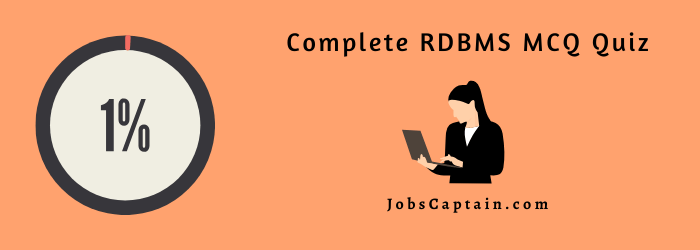
Return to Programming Language Quiz List
RDBMS MCQ Quiz
Question 1: A relational database consists of a collection of _________ .
(A) Tables
(B) Fields
(C) Records
(D) Keys
Question 2: A ___________ in a table represents a relationship among a set of values.
(A) Column
(B) Key
(C) Row
(D) Entry
Question 3: Which term is used to refer to a row?
(A)Attribute
(B) Tuple
(C) Field
(D) Instance
Question 4: For each attribute of a relation, there is a set of permitted values, called the __________ of that attribute.
(A) Domain
(B) Relation
(C) Set
(D) Schema
Question 5: _______ is a procedural language.
(A) Domain relational calculus
(B) Relational algebra
(C) Tuple relational calculus
(D) Query language
Question 6: A ________ is a query that retrieves rows from more than one table or view.
(A) Start
(B) End
(C) Join
(D) None of the mentioned
Question 7: Which join refers to join records from the write table that have no matching key in the left table are include in the result set?
(A) Left outer join
(B) Right outer join
(C) Full outer join
(D) Half outer join
Question 8: Which of the following creates a virtual relation for storing the query ?
(A) Function
(B) View
(C) Procedure
(D) None of the above
Question 9: The number of attributes in relation is called as its _________ .
(A) Cardinality
(B) Degree
(C) Tuples
(D) Entity
Question 10: Functional Dependencies are the types of constraints that are based on _________ .
(A) Key
(B) Superset key
(C) Key revisited
(D) None of the above
Question 11: ______ forms are based on the concept of functional dependency.
(A) 1NF
(B) 2NF
(C) 3NF
(D) 4NF
Question 12: Trigger are supported in ___________ .
(A) Delete
(B) Update
(C) Views
(D) All the above
Question 13: _______ forms has a relation that possesses data about an individual entity.
(A) 2NF
(B) 3NF
(C) 4NF
(D) 5NF
Question 14: Referential integrity is directly related to ___________ .
(A) Relation key
(B) Foreign key
(C) Primary key
(D) Candidate key
Question 15: E-R modeling technique is _____________ .
(A) Tree structure
(B) Top-down method
(C) Bottom-up method
(D) Right-left approach
Question 16: ER Model Comes under ___________ .
(A) Physical data Model
(B) Record based logical Model
(C) Object based logical Model
(D) None of Above
Question 17: A _________ is an association among several entities.
(A) Relationship
(B) Association
(C) Set
(D) combination
Question 18: What type of join is needed when you wish to include rows that do not have matching values?
(A) Equi-join
(B) Natural join
(C) Outer join
(D) All of the above
Question 19: ____________ is NOT a type of SQL constraint.
(A) PRIMARY KEY
(B) FOREIGN KEY
(C) ALTERNATE KEY
(D) UNIQUE
Question 20: In a one-to-many relationship, the entity that is on the one side of the relationship is called a(n) ___________ entity.
(A) parent
(B) child
(C) Instance
(D) Subtype
Question 21: ____________ is a single-entity instance of one type related to many entity instances of another type?
(A) One-to-One Relationship
(B) One-to-Many Relationship
(C) Many-to-Many Relationship
(D) Composite Relationship
Question 22: Properties that describe the characteristics of entities are called _______________ .
(A) Entities
(B) Attributes
(C) Identifiers
(D) Relationships
Question 23: _____________ is the function of the union operation?
(A) It combines the results of any two different queries
(B) It combines the results of two different queries which have the same set of attributes in the select clause
(C) It combines the results of two different queries which have the same condition in the where clause
(D) It gives the Cartesian product of the results of any 2 queries
Question 24: In relation algebra a new term was defined by codd as __________:
(A) Relation
(B) Relation completeness
(C) Relation operation
(D) Relation selection
Question 25: ___________ is a unary operation.
(A) Selection operation
(B) Primitive operation
(C) Projection operation
(D) Generalized selection
Question 26: How many primitive operators of relation algebra as proposed by codd?
(A) 2
(B) 3
(C) 4
(D) 6
Question 27: ______________ is based on specifying a number of tuple variables?
(A) Tuple relation calculus
(B) Domain relational calculus
(C) Both
(D) None of above
Question 28: ________ is a collection of tools for describing data,data relationship,data relationship and constraint.
(A) Instances
(B) schema
(C) Data model
(D) SQL
Question 29: It refers to set of one or more columns that designates the __________ in a referential integrity constraint.
(A) Select key
(B) Foreign key
(C) Write key
(D) None of the above
Question 30: In which year relational algebra became prominent after the relational model of database was published?
(A) 1969
(B) 1970
(C) 1971
(D) 1972
Question 31: ______________ is used for interfacing with RDBMS.
(A) IBM
(B) SQL
(C) ANSI
(D) ORACLE
Question 32: ______________ indicates the maximum number of entities that can be involved in a relationship?
(A) Minimum cardinality
(B) Maximum cardinality
(C) ERD
(D) Greater Entity Count
Question 33: ___________ is a relationship called when it is maintained between two entities.
(A) Unary
(B) Binary
(C) Ternary
(D) Quaternary
Question 34: A tablespace is further broken down into ________ .
(A) Tablespace
(B) Segments
(C) Extents
(D) Blocks
